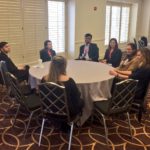
Event

Vascular Calcification… It’s Complicated
The Vascular Discovery meeting in San Francisco last week was whirlwind of learning and networking. My favorite moment was at the Friday 7 am Early Career Training session where, by coincidence, I ended up at the same table with @Ritu_Ganguly1, @MoradiShayan and @JeffHsuMD. We had all signed up to provide social media coverage of the conference via the Twitter account of the Journal of the American Heart Association (JAHA), so it was great to meet them in person. Later in the day, Ritu and I worked (read: laughed and cried) through the Genome Editing Bootcamp together, a challenging case-based workshop led by the excellent Dr. Kiran Musunuru.
As discussed in my pre-conference blog, vascular research is extremely pertinent to chronic kidney disease. Children on dialysis can manifest the same arterial calcification as a 70 year old. An established mechanism in vascular calcification is the phenotype switch where vascular smooth muscle cells start behaving like bone cells, secreting matrix vesicles filled with calcium-phosphate mineral into the extracellular matrix. At the Vascular Discovery meeting Dr. Elena Aikawa discussed advances made in the understanding of matrix vesicles, which are critical precursors of microcalcifications. In a JCI paper, her group reported co-localization of the protein sortilin with caveolin-1 and tissue nonspecific alkaline phosphatase, and defined sortilin’s role in loading mineral into vesicles. Dr. Aikawa raised a follow up question: Would future therapies that block activation of sortilin prevent microcalcifications, and thus prevent vascular calcification?
Dr. Catherine Shanahan, who described the role of programmed cell death or apoptosis in dialysis-associated vascular calcification, discussed the interaction of aging and vascular cell phenotype change at her Vascular Discovery talk. Her lab has been examining the nuclear lamina, or network of filament proteins which are a part of the cell nucleus. It turns out that the aging vascular smooth muscle cell accumulates prelamin A (see Circulation Research paper), which leads to DNA damage and triggers the osteogenic phenotype switch. This raises the intriguing question: Can we reverse cell aging to block vascular calcification?
The nature of scientific research is that more questions are raised as progress is made. Scientific meetings such as Vascular Discovery have an important role in updating investigators and clinicians, fostering new collaborations and training early career professionals.
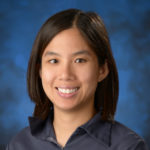
Wei Ling Lau, MD is Assistant Professor in Nephrology at University of California-Irvine. She is currently funded by an AHA Innovative Research Grant, and has been a speaker for CardioRenal University and the American Society of Nephrology. Follow her on Twitter @Kidneys1st
Vascular Discovery 2018: Prologue
This year, the previously known ATVB conference will debut its new name as the Vascular Discovery: From Genes to Medicine 2018 Scientific Sessions. The collaboration of three well-known AHA Scientific Councils, (the Council on Arteriosclerosis, Thrombosis and Vascular Biology, the Council on Peripheral Vascular Disease and the Council on Genomic and Precision Medicine) will provide a unique opportunity for attendees to make the most out of their scientific experience, network with connoisseurs in the field and establish new collaborations.
As a scientist in the early stages of my career, my conference agenda will be focused on the followings:
Early Career Training Sessions – Hallmark of the Event

Based on my experience from the last few years, I will look forward to attending the Early Career Training sessions. I was always captivated by the fruitfulness of these short sessions and how it helped me to shape my moving-forward career. This year, the first and second day of the conference will start with Early Career Training sessions. On Thursday, the Early Career Committee will share insights about succeeding at every stage of your career featuring talks on starting your own lab, work-life balance and transitions to the industry. The session on Friday morning is organized in cooperation with the ATVB Early Career Committee and will be focused on skills needed for difficult situations.
In my opinion, the points that will be discussed during talks in these sessions and their following Q & As will provide ample insights about how to modify your move toward future steps of your career.
Network, Network, Network!
The smaller setting of Vascular Discovery ‘18, compared to AHA Scientific Sessions or similar events, allows you to see more and to be seen more. You will have more exposure to your peers and experts in your field of interest during different segments of the event. Try to stay away, as much as possible, from peers and people from your own institution and find new connections.
Before heading to the event make sure that you ask yourself “why am I going?” Are you looking for a possible position? Is it a recommendation that you may want? Are you interested in starting collaborations? Come up with a goal and make sure you accomplish it instead of aimlessly wandering around.

Now that you have a networking goal, make sure to have an effective introduction when meeting someone new. Make eye contact, smile, and state your name and institution clearly then, listen (believe it or not, it is easy to miss these points when you are nervous).
Also, make sure you are not forgetting business cards and lean on “I just gave away my last one!” Moreover, have in mind that you will not remember the important details of every conversation, so be prepared to take notes. The whole purpose of networking is to connect with people in the near future and taking notes will make it easier.
Personally, I believe that networking is one of the priorities in attending any scientific sessions and being proactive and prepared for it will help you to make sure that you get the most out of it.
Poster Sessions – Land of Opportunities
If you are attending Vascular Discovery ‘18, you are probably aware that your research falls within the overall themes of the conference. Therefore, you find much more topics that you will be interested in, compared to more comprehensive meetings.
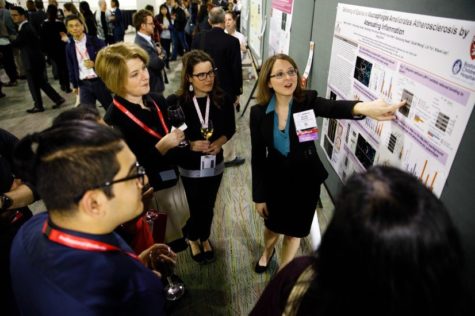
This point will specifically come to your realization during the poster sessions. Posters are one of the crucial currencies for communications and connections. Given the fact that how powerful posters are in making connections and receiving feedback, whether you are the presenter or the presentee, you should make sure to plan your attendance to the “land of opportunities.” Based on personal experience, visiting the posters from well-known research groups in your field of interest can help fostering strong working relationships. It would be helpful if you familiarize yourself with the names and even pictures of people who you may be interested to talk to, so you can approach them during the poster sessions.
In the case of you being the presenter, it is recommended that you prepare different versions of talking points, a short elevator pitch for less curious and a longer version for one’s with deeper interests. Finally, be open, enthusiastic and passionate during your presentations and do not be shy to ask people earlier in the day to stop by your poster.
Final Words
Vascular Discovery ‘18 will be filled with sessions discussing cutting-edge research from world-renowned scientists. Therefore, it would be worth it if you spend time on the final program and pick out the sessions/talks which you would be interested in. In case you will not be able to attend this meeting or some of the sessions, make sure to follow my special coverage of the event on my twitter (@MoradiShayan).
At the end of the day, also note that a full day of scientific quests may get overwhelming, so plan to have fun after the conference and enjoy the beauties of San Francisco.

Shayan is a caffeine-dependent Ph.D. Candidate at the Saha Cardiovascular Research Center, University of Kentucky. His research area is focused on vascular biology and lipid metabolism. He tweets @MoradiShayan, blogs at shayanmoradi.com and he is the Winner of World’s Best Husband Award (Category: nagging).
Appetite: An Important Symptom To Assess In Patients With Heart Failure
Today I attended an impressive defense of Christina Andrea (@C_Andreae) of her PhD dissertation on appetite in patients with heart failure. She highlighted the importance of a symptom in patients with heart failure, that is rarely assessed: Appetite.

Appetite, or the desire to eat, is a common problem in patients with heart failure. Appetite is important in patient with heart failure for maintaining food intake and a healthy weight. There is a lack of knowledge on the significance of problems with decreased appetite and on which factors that might contribute to decreased appetite and whether decreased appetite has an influence on patients’ health status.
In her studies she found that 38% of patients with heart failure (despite that the majority had mild to moderate heart failure symptoms i.e., NYHA class II) experienced an appetite level that put them at risk of weight loss.
In one of her studies, which she presented last year on the #AHA17 congress, she found that patients with heart failure who were more physically active have better appetites compared to patients who are less physically active.
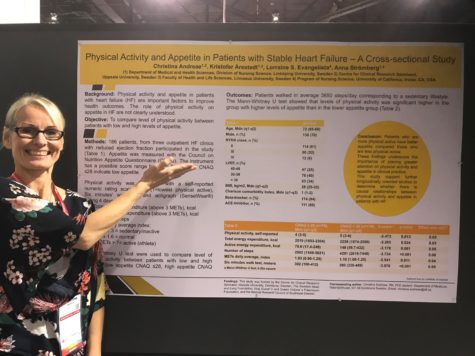
Other factors that she found which are associated with loss of appetite were older age, symptoms of depression, sleep problems, impaired cognitive function and suboptimal medical treatment and should be recognized in all these patients. Loss of appetite needs attention as it is likely to lead to worsened nutrition, but also because she found that loss of appetite is associated with lower health status.
So what should we do with this new information?
Christina suggest that the assessment of appetite should be incorporated as routine in nutritional care. For instance, an instrument that could be used is CNAQ: Council on Nutrition Appetite Questionnaire. The results could be used as a basis for communicating appetite with patients and their family members. Furthermore, she found a lot of factors associated with appetite, health care professionals should pay attention to patients who are older, as well as patients with depressive symptoms, sleeping problems, cognitive decline, low physical activity and patients with suboptimal treatment.
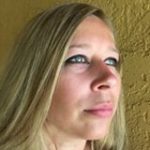
Leonie Klompstra is a Nurse Scientist at the Linköping University in Sweden. Her primary focus is on heart failure and rehabilitations.
Connecting At Conferences: Networking At Its Best
This March in New Orleans, the Council on Epidemiology and Prevention with the Council on Lifestyle and Cardiometabolic Health hosted the 2018 EPI Lifestyle Scientific Sessions. A great part of the early career programming this year were the Connection Corners. Small roundtable discussions led by two established investigators drew early career attendees to learn about grant writing, crafting effective elevator speeches, and improving their curriculum vitae (CV). I was lucky enough to listen in (while snapping photos and live tweeting the conversation) and have some highlights to share.

Drs Brooke Aggarawal and Mercedes Carnethon talk with early career investigators about crafting your elevator speech at AHA Epi Lifestyles 2018 in New Orleans.
Practice your Elevator Speech
Dr. Brooke Aggarawal and Dr. Mercedes Carnethon
An elevator speech is a 30-second “pitch” or summary named for when you find yourself in an elevator with a stranger, and they ask “What do you do?” Of course, you could encounter that question in many scenarios that necessitate an engaging, brief, and understandable response.
Dr. Brooke Aggarawal and Dr. Mercedes Carnethon had a variety of advice on how to develop your pitch, as well as some unique ideas. Dr. Carnethon’s biggest takeaway was to have several elevator speeches – one for each research topic, as well as one for various scenarios.
- Brainstorm situations you may need an elevator speech
- Family gatherings and dinners
- Social gatherings with new friends
- New colleagues at a conference
- On an interview
- In an elevator
- Outline your research topics – maybe you study cardiovascular disease, but with a focus on sleep, or diabetes, or congenital abnormalities. You probably have a project or two that goes along with each of those topics.
The first step is to write down your speech and then simplify the details into one message per pitch. That means all the details and objectives and methods you might explain to your mentor or at a poster presentation won’t have a place in this elevator speech.
Dr. Brooke Aggarawal had some great advice. Avoid using jargon and be concise while still answering the question “So what?”. And the answer to “So what?” will be different depending on who you’re talking to.
When simplifying your project into a single method, you may try to:
- Develop analogies that paint a picture for your listener
- Open and/or close with a question that piques their interest
And lastly, practice practice practice! Especially if you’re preparing for an interview, this answer to “tell us about yourself” should roll of the tongue and demonstrate your passion for your research.
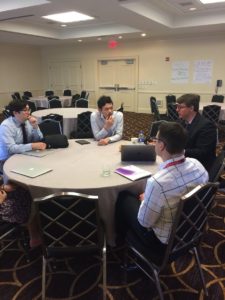
Drs.Christopher Imes and John Wilkins talk to early career investigators about “Boosting Your CV” at AHA Epi Lifestyle 2018 Connection corner.
Boosting Your CV
Dr. Christopher Imes and Dr. John Wilkins
This Connection Corner was all about how to get your message across quickly and concisely in your curriculum vitae. Just like with resumes, your CV is typically skimmed by the reader, and despite the traditional format, there are some steps you can take to stand out.
Dr. John Wilkins pointed out that you should utilize the librarians – experts in information sciences – at your institution to summarize your “research impact”. They can do searches that summarize your publications, citations, etc. that you can include in a biosketch intro that precedes your CV. Plus, a biosketch is the ultimate way to make sure the first thing the reader sees is the message you want them to!
The laptops came out and Dr. Imes and Dr. Wilkins read and provided feedback on CVs for early investigators at various levels – PhDs, post-docs, and early career professors. The last point they drove home was that while it may seem inconsequential, pristine formatting and grammar is imperative in your final draft. Typos and bad spelling leave a bad impression that can move your CV to the “no” pile before they even finish reading it.
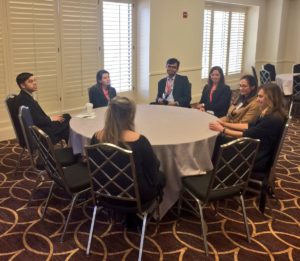
Drs. Norrina Allen and Deepak Gupta field questions at AHA EPI Lifestyle 2018 about grant writing.
Specific Aims
Dr. Norrina Allen and Dr. Deepak Gupta
The group around the table at the grant writing Connection Corner was an accomplished one! With 4 K-awards submitted or about to be between them, they had plenty of questions for Dr. Norrina Allen from Northwestern and Dr. Deepak Gupta from Vanderbilt.
The two main points of the discussion were to craft your career development plan in a way that conveys responsibility, innovation, and prospect to the grant readers, as well as:
Mentoring questions were a big part of this discussion. One person asked, “Should your K-award mentor be someone you’ve worked with before, or someone in the field you’re aiming to get new training in?” Drs. Allen and Gupta answered – definitely someone you have a connection with. They explained that the primary mentor on your K-award is for the career development, while the training goals you set will be met with the network of content and methods experts you put together. Similarly, they noted that the aims for your K grant should match the training domains you want to achieve.
Drs. Allen and Gupta emphasized that for career development grants, it’s important to be specific in your career trajectory section about how that grant is a stepping stone for your future goals. They mentioned being particularly impressed when grant writers state how that K-award (for example) will set them up to submit an R01 on topic “<enter Title>” in year # of their career development award. While you don’t need that R01 grant written up in your head, having an idea of the title and the timeline shows planning and promise.
Lastly, the classic question: How many aims should you have? The answer, like many things, is that it depends. Too many aims, or aims that are too diverse, will water down the focus of your overall proposal. The aims you craft need to be achievable during the time period, concise and straight forward, and should not be interdependent on one another, whether the success of one depends on the success of another.
If you couldn’t be there in person, I hope these pearls of wisdom were the next best thing! What’s on your to do list for career development this month?
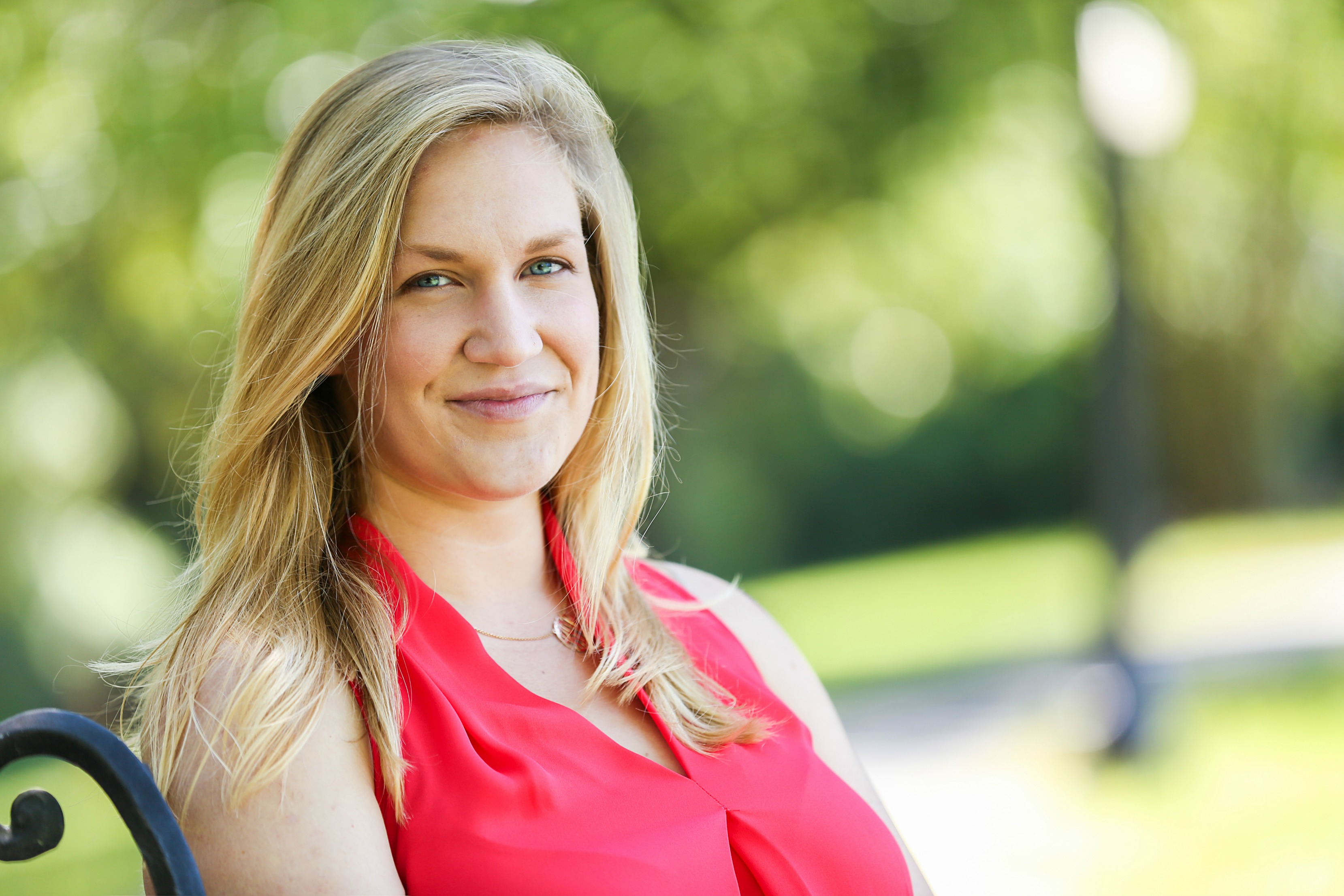
Bailey DeBarmore is a cardiovascular epidemiology PhD student at the University of North Carolina at Chapel Hill. Her research focuses on diabetes, stroke, and heart failure. She tweets @BaileyDeBarmore and blogs at baileydebarmore.com. Find her on LinkedIn and Facebook.
Shift Your Perspective To Get The Most Out Of Mentoring
The AHA Epidemiology and Prevention and Lifestyle and Cardiometabolic Health Scientific Sessions is quite different from AHA Scientific Sessions. Smaller in size and more focused, with few concurrent sessions and ample coffee breaks, I enjoyed attending the numerous Early Career sessions. They varied in topic and format: “Connection Corners” were short round-table discussions twice a day with focused conversations on ‘beefing up your CV’, the grant writing process, developing a catchy elevator speech, and leveraging non-NIH funding. Both the EPI-Prevention and Lifestyle councils had lunchtime panels at the end of their annual business lunches, and had the audience asking questions about avoiding burnout in academia and global collaboration in cardiovascular research.
To end the week, the Early Career Council outdid themselves with the early morning ‘fire-side’ chat with Drs. Emelia Benjamin, MD ScM from Boston University School of Medicine, Norrina Allen, PhD from Northwestern Medicine, Jean-Pierre Després, PhD from Laval University in Quebec, Chiadi Ndumele, MD MHS from Johns Hopkins Medicine, and Lenny Lopez, MD MDiv MPH from UC San Francisco.

Drs. Emelia Benjamin, Jean-Pierre Depres, Chiadi Ndumele, Lenny Lopez, and Norrina Allen (left to right) provide eye-opening mentoring advice to early career investigators at the EPI Lifestyles Scientific Sessions 2018 in New Orleans, LA.
If you missed this morning session, no worries! I have you covered. The panel conversation, led by Dr. Emelia Benjamin, started with finding your niche as an early career investigator, and developed into a great discussion on building a mentoring team and planning your own path.
Using Sli.do to anonymously ask questions allowed for an unbiased view of what the audience was thinking. And overwhelmingly were questions along the lines of:
- What do you do if your mentor selects a niche for you that doesn’t excite you?
- How do you separate your niche from your mentor?
- What can you do to fix a fall-out with your mentor?
I found these questions concerning! To me, they reflect a mentee perspective that 1) once you’re assigned a mentor, you’re stuck with them; 2) your mentor is the be-all-end-all guide in your career path; and 3) you must do everything your mentor tells you.
My first response to this perspective is: we’ve got to shift this mindset! If your relationship with your mentor is that of a duckling and mother goose, something has got to change. A mentor that “assigns” a research niche to you is either a Tormentor or is responding to your lack of initiative. If the former, you should find a new mentor. Your institution will have a number of resources including a faculty affairs office or an ombudsman and possibly a mentoring program that will help you find a mentor that best fits with your needs.
If the latter, you’ve got some work to do! But the career panel provided some great advice on how to get started. (So do Vineet Chopra, MD MSc, Vineet M. Arora, MD MAPP, and Sanjay Saint, MD MPH in an article titled “Will you be my mentor?” published in JAMA last year).
Make the most of your time
Mentors have a number of responsibilities and how they have made their own career path and achieve work life balance is a great indicator if you will be a good fit. Do you aspire to a career like theirs? Do you admire their work-life balance? They might make a great life or career mentor for you.
Just as you expect your mentor to give you their full attention when discussing your goals, you must respect their time as well! That means giving thought to your research goals, planning the steps to get there, and using their expertise and experience to provide direction and improve your process.
Set up a meeting with your mentor and prepare an agenda beforehand. Know the topics you’d like to cover, whether their input on goals and milestones, plans for research projects, or ideas to brainstorm on. Preparing an agenda shows respect for both of your times and keeps you on track for a productive meeting. Jot down action items and follow-up after the meeting.
Judy T. Zerzan, MD MPH and coauthors discuss “managing up” and how to take responsibility for your half of the mentor-mentee relationship in “Making the Most of Mentors: A Guide for Mentees.”
Earlier this year, Dr. David Werho wrote about sponsorship versus mentoring in his 2-part article “When Mentoring Isn’t Enough”. Read Part 1 and Part 2 to learn about why dependability pays off, how to diversify and be the protégé you want, and why it’s worth it to do your homework.’
One is the Loneliest Number
Another solution to mentor woes is creating a mentor network. Over and over, the panel expounded on the advantages of having both a primary mentor and a mentoring group. This structure is explicit in career development grants, where the primary mentor supports your career development initiatives, and the content and methods experts support your training goals. Content and methods mentors in your network can also help you explore different areas in your field as you work to identify your research niche.
A mentor network means different researchers with different backgrounds and different perspectives. Bouncing your research ideas off them results in contrasting views, some that will jive more with you, and some that will make you think. Instead of being molded into a “mini”-me mentee, a mentor network helps you build the scaffolding upon which you’ll grow into your own independent researcher.
I’ll touch more on this idea later, but here’s a great read from Yan Shen, Richard D. Cotton, and Kathy Kram for the MIT Sloan Management Review. Even if you are post-tenure, you still benefit from a strong mentoring network! Read more from Kerry Ann Rockquemore in “Posttenure Mentoring Networks.”
Identifying a Niche
The pre-established theme of the Friday morning early career session was how to “Identify Your Niche”. While much of the discussion centered around mentoring and its supportive role in finding your niche, there was also focused advice on how to find your way.
The panel emphasized that as an early career investigator, it’s imperative to utilize this time to identify and achieve the additional training you see as important to your overall career goals. While this may be in the form of a post-doctoral position or a K-award, it can also be informal in the research projects you pursue and the skills you acquire.
Dr. Emelia Benjamin, who provides mentoring support to early career faculty at Boston University, gave us 2 homework assignments to help us plan our way.
First, reflect on where you’ve been and where you’re going. A 1-page personal statement makes a powerful addition to your CV, and the journey to this final product will help you learn to tell your story as a connected arc, rather than a zig-zag path jumping from topic to topic. The evolution of your research niche from project to project is hardly evident in your publication list, but through narration and self-reflection you can illustrate your approach to the scientific process and summarize where you might go next. Not only will you provide a picture of your research goals and personality to anyone reading your CV, but you will likely have a few “Aha!” moments discovering connections between projects you hadn’t seen before.
Second, diagram your mentoring network. It’s important to visualize this – are all of your mentors above you? Below you? Horizontal to you? Peers? Are they in the same division, institution, or all distance? A mixture is key, but the components of that mixture depends on your research and career goals. Dr. Chiadi Ndumele from Johns Hopkins Medicine shared his take on 5 valuable types of mentors to have:
- Methodological mentors are those you go to for questions and feedback about approach.
- Content or clinical mentors are those you go to about patient care of content expertise.
- Life mentors are those whose work-life balance is one you admire.
- Career mentors help you step back and see the big picture, particularly the asks you should say no to.
- A brainstorm mentor plays devils advocate and is a great sounding board to bounce ideas off of that also bounces back.
 Dr. Emelia Benjamin utilizes the theories from Kathy Kram, Monica Higgins, and David Thomas on “Creating Developmental Networks” and “Reconceptualizing Mentoring” with her early career faculty at BU. Take a cue from her, and use this worksheet, Define your Developmental Network, to identify the gaps in your mentoring network, and take the first step to filling them.
Dr. Emelia Benjamin utilizes the theories from Kathy Kram, Monica Higgins, and David Thomas on “Creating Developmental Networks” and “Reconceptualizing Mentoring” with her early career faculty at BU. Take a cue from her, and use this worksheet, Define your Developmental Network, to identify the gaps in your mentoring network, and take the first step to filling them.

Bailey DeBarmore is a cardiovascular epidemiology PhD student at the University of North Carolina at Chapel Hill. Her research focuses on diabetes, stroke, and heart failure. She tweets @BaileyDeBarmore and blogs at baileydebarmore.com. Find her on LinkedIn and Facebook.
On My Way To NoLa – AHA EPI | Lifestyle Specialty Conference
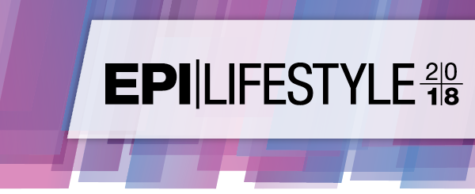 The AHA EPI | Lifestyle Specialty Conference will be smaller and more specific than any conference that I have attended. My conference experience has consisted of, for the most part, international meetings that are held in large venues such as Experimental Biology (EB) in the San Diego Conference Center. This center boast 525,701 gross ft2 on the ground level and 90,000 ft2 of column-free space in the Sails Pavilion on Upper Level. EB uses this vast conference space to house over 14,000 researchers, 400 oral sessions that are hosted by 6 societies and 35 guest societies. To attend an event of this size can prove to be too exhaustive to experience everything that is being offered. I have opted to attend the AHA EPI | Lifestyles specialty conference because it is smaller and focused on Health Promotion: Risk Prediction to Risk Prevention.
The AHA EPI | Lifestyle Specialty Conference will be smaller and more specific than any conference that I have attended. My conference experience has consisted of, for the most part, international meetings that are held in large venues such as Experimental Biology (EB) in the San Diego Conference Center. This center boast 525,701 gross ft2 on the ground level and 90,000 ft2 of column-free space in the Sails Pavilion on Upper Level. EB uses this vast conference space to house over 14,000 researchers, 400 oral sessions that are hosted by 6 societies and 35 guest societies. To attend an event of this size can prove to be too exhaustive to experience everything that is being offered. I have opted to attend the AHA EPI | Lifestyles specialty conference because it is smaller and focused on Health Promotion: Risk Prediction to Risk Prevention.
Since Bailey DeBarmore went into great detail outlining the schedule for the meeting, I will not expound on that any further. Although I have more of a molecular biology/biomedical background that focus on oxidative stress in the microvasculature, I was surprised to see this meeting offered topics that would enhance not only my knowledge of health promotion, but also contribute to my scientific research. The section Hypertension: Guidelines and Prevention, Rapid Fire Oral Presentations consist of several researchers/clinicians that will present their work in 10 minute burst, giving the vibe of “speed dating”. This is an interesting way to present topics, but it is also challenging! From my experience, there is so much to say and so little time to say it. Which, is true. The topics are so specific, one is required to have background knowledge of the topic to understand the speakers’ findings. It is also a good way for the listener to gain a vast amount of information in a short time.
Additionally, I am excited about several of the sessions that will be held at AHA EPI |Lifestyle Specialty Conference. My career trajectory has taken me through proteomics, genomics, and metabolomics as mechanistic tools to elucidate the onset of inflammation, and subsequently, cardiovascular disease. The intersection between theoretical prediction of a disease to the onset of the disease, and ultimately the prevention of the disease by reducing the risk is the obvious pathway of ameliorating chronic diseases. The topic of interest to me, due to the time constraints, are as follows:
- Session 2 – Hypertension Guidelines and Prevention. Now that the new guidelines are beginning to be accepted among the clinical/scientific communities, it will be interesting to learn more about the methods being initiated to accomplish these new levels.
- Session 5 – Cardiovascular Biomarkers I expect will introduce more detail about the markers clinicians use for early identification of cardiovascular disease and what can be done to truncate its occurrence.
- Session 6 – Hot off the Press – there are several new articles that have been released this year. Among them, Schoenthaler et al addressed social needs of hypertensive patients.
a. For decades there has been arguments as to whether one should have a low fat or low carbohydrate diet to lose a weight. This study by Gardner et al, will add to what we know about the impact diet have on weight loss in overweight adults using genotype patterns and/or insulin secretions as the associated factors.
b. The study by Powell-Wiley et al, suggest there is a correlation between crime and physical activity and obesity among African American women. Since we know there are many variables that plays a role in obesity and physical activity, I am interested to learn more about their study and what variables were tested to come to the conclusions that they have drawn.
c. Fuchs et al explored the use of low-dose diuretics to optimize prehypertensive values as a means of lowering blood pressure.
d. Banck et al discussed racial disparities among young adulthood modifiable risk factors in the incidence of type 2 diabetes during middle adulthood as a modifiable risk factor. - Session 10 – I have learned about 3 of the omics and the more I learn the more that seem to be identified. The Omics section, I will imagine, will cover the well-known, proteomics, genomics and metabolomics; however, some that are exciting, due to them being novel to me, are the Trans-Omics and Phenomics.
- Session 11 – The William B. Kannel MD Memorial Lectureship in Preventative Cardiology
- Session 12 – The debate will cover some of the Pros and Cons of medical cost. The main argument when it comes to cardiovascular care is the rising cost of medical treatment. This session will cover some of the cost associated with cardiovascular disease treatment, and I hope, some ways that they can be overcome by prevention.
- It is my desire, during this AHA EPI | Lifestyles conference to disseminate information that will assist in empowering clinicians, researchers, and the general population of methods that can be taken to promote health and a healthy lifestyle. Hope to see you there in person or online to share thoughts on the lessons learned during this conference.

Anberitha Matthews, PhD is a Postdoctoral Fellow at the University of Tennessee Health Science Center in Memphis TN. She is living a dream by researching vascular injury as it pertains to oxidative stress, volunteers with the Mississippi State University Alumni Association, serves as Chapter President and does consulting work with regard to scientific editing.
AHA EPI | Lifestyle 2018 – Health Promotion: Risk Prediction To Risk Prevention
“Epidemiology is the study of the causes and distributions of diseases in human populations so that we may identify ways to prevent and control disease.”
(JM Last, A Dictionary of Epidemiology)
In a 2013 commentary, Sandro Galea reminds us of the definition of epidemiology [above] and notes that it “neatly communicates 2 central actions for the field:
- we identify causes so that
- we may intervene….
However, in practice, academic epidemiology now spends most of its time concerned with identifying the causes and distributions of disease in human populations and far less of its time and imagination asking how we might improve population health…”
In a seminal paper in 1985, Geoffrey Rose showed that populations are not the sum of their individuals, highlighting the difference between epidemiology for public health and individual-based medicine. In a recent paper, Dr. Rogawski and coauthors speak to this, pointing out that individual level risk factors identified in population based studies “do not always inform public health interventions since targeting of interventions occurs when individuals present to the healthcare system,” or “medical epidemiology.”
AHA EPI | Lifestyle Scientific Sessions – March 20-23, 2018 (New Orleans, Louisiana)
Later this month, AHA Epidemiology and Lifestyle Councils travel to New Orleans for the annual specialty conference. The theme? Health Promotion: Risk Prediction to Risk Prevention. The 4-day conference will feature 11 sessions, 3 poster sessions, 6 Early Career events, and more. Last year in Portland, Oregon, the conference focused on “Location, Location, Location: Improving Individual and Community Health,” and in 2015 in Baltimore, Maryland “From Precision Medicine to a Culture of Health.” The past 3 years parallel the surge of interest in consequentialist epidemiology, with noted efforts into precision medicine through mHealth interventions as well as theoretical interventions of moving population-wide blood pressure by 1 mmHg.
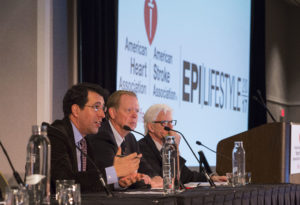
Drs. Daniel Rodríguez, Wayne Rosamond, and Robert Ross answer questions at Opening Sessions, AHA EPI I Lifestyles 2017 in Portland, Oregon.
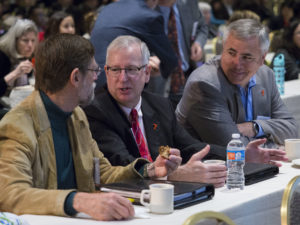
Drs. Darwin Labarthe, David Goff, and Donald Lloyd-Jones catch up before opening session in Portland, OR at AHA EPI | Lifestyle 2017. Make sure to get your Life’s Simple Seven pin at your next AHA conference!
Early Career Events at AHA EPI | Lifestyle
Over this past year, I’ve become more active in the American Heart Association than I have in any other member organization and it’s all due to being an Early Career Blogger. After attending Early Career events at AHA Scientific Sessions in November 2017 – from luncheons to networking to panel sessions – I keep my eyes peeled for similar events at all conferences I attend. The focus for Early Career Events at EPI | Lifestyle this year will be on international collaboration in cardiovascular epidemiology through a “speed dating” format session on Thursday, and a roundtable luncheon on Friday. In addition, the Lifestyle Council will host a 3 Minute Thesis (3MT) Competition at their early career lunch, and early Friday morning is “Lost or Found? Identifying your Niche in Academic Research.”
Don’t Miss Out!
Between the coffee breaks, be sure to catch these notable epidemiologists and scientists who will be speaking throughout the week in New Orleans. I think their research and background paint the perfect picture for a conference focused on health promotion.
I’ve included their Twitter handle when I can – so be sure to tweet them your questions, and tag #EPILifestyle18 so we can follow, too!
Health Promotion: Risk Prediction to Risk Prediction, Opening Remarks (Session 1)
Alfredo Morabia, MD, PhD, MPH, MSc is a professor of clinical epidemiology at Columbia University Mailman School of Public Health. His research spans from history of epidemiology and health ethics to urban health projects, such as health of first responders following 9/11. Tweet him @AlfredoMorabia.
Angela Odoms-Young, PhD is an associate professor at the University of Illinois at Chicago and a fellow of the Institute of Health Research and Policy, which aims to advance health practice and policy through collaborative research. Her current research projects at the Illinois Prevention Research Center include policy research and evaluation on environmental change related to nutrition and obesity. Tweet her @OdomsYoung.
Mintu Turakhia, MD, MAS, FAHA is an associate professor of cardiovascular medicine at the Palo Alto VA and Executive Director of Stanford University’s new Center for Digital Health. His research focuses on heart rhythm disorders through outcomes research and clinical practice. Tweet him @LeftBundle.
Hypertension: Guidelines and Prevention, Rapid Fire Oral Presentations (Session 2)
Paul Whelton, MD MSc will recap the new Hypertension Guidelines unveiled at #AHA17 and orient them within the guise of population health and disease prevention.
David Kritchevsky Memorial Lecture (Session 5)
Barry M. Popkin, PhD established the Division of Nutrition Epidemiology at University of North Carolina at Chapel Hill as well as the NIH funded UNC interdisciplinary Obesity Center. He developed the Nutrition Transition theory and studies these dynamic shifts in dietary intake and physical activity around obesity on a national and global scale.
Richard D. Remington Methodology Lecture (Session 9)
Joel Kaufman, MD, MPH is a physician epidemiologist and interim dean at the School of Public Health at the University of Washington. His research focuses on environmental factors in cardiovascular and respiratory disease, and is a PI on MESA Air.
William B. Kannel MD Memorial Lectureship in Preventative Cardiology
Emelia J. Benjamin, MD, ScM, FAHA is a professor at the Boston University School of Medicine and longtime researcher on the Framingham Heart Study. She focuses on the intersection of genetic, epidemiology, and prognosis of cardiovascular conditions and biomarkers, particularly atrial fibrillation. Tweet her @EmeliaBenjamin.

Bailey DeBarmore is a cardiovascular epidemiology PhD student at the University of North Carolina at Chapel Hill. Her research focuses on diabetes, stroke, and heart failure. She tweets @BaileyDeBarmore and blogs at baileydebarmore.com. Find her on LinkedIn and Facebook.

